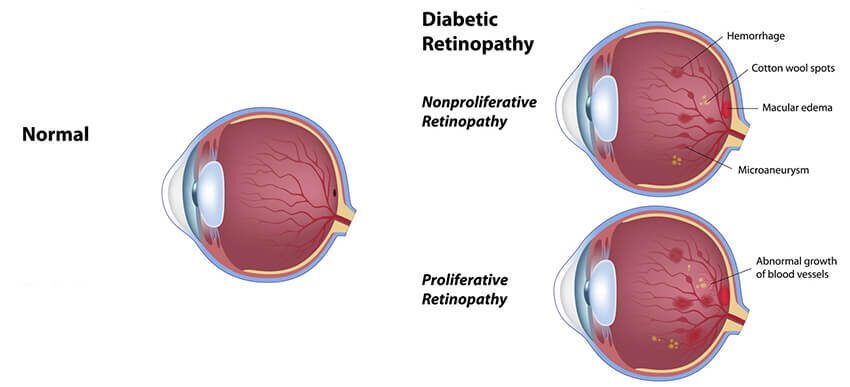Diabetes affects your body’s ability to use and store sugar. The high blood sugar levels can damage blood vessels in the retina, causing them to leak fluid or blood. The leaking fluid causes the retina to swell which can negatively affect your vision and potentially lead to blindness. This is known as “diabetic retinopathy”.
Types Of Diabetic Retinopathy
There are two types of diabetic retinopathy: nonproliferative diabetic retinopathy (NPDR) and proliferative diabetic retinopathy (PDR).
NPDR, commonly known as background retinopathy, is an early stage of diabetic retinopathy. In this stage, tiny blood vessels within the retina leak blood or fluid. The leaking fluid in the eyes causes the retina to swell or to form deposits called exudates.
PDR is present when abnormal new vessels begin growing on the surface of the retina or optic nerve. The main cause of PDR is widespread closure of retinal blood vessels, preventing adequate blood flow. The retina responds by growing new blood vessels in an attempt to supply blood to the area where original vessels closed.
Unfortunately, the new abnormal blood vessels do not resupply the retina with normal blood flow. The new vessels are often accompanied by scar tissue that may cause wrinkling or detachment of the retina.
How Is Diabetic Retinopathy Diagnosed?
A medical eye examination is the only way to diagnose diabetic eye disease. It is important to get yearly dilated eye exams because eye care professionals can often diagnose NDPR and PDR before you are aware of any vision problems.
Diabetic Retinopathy Treatment
The best treatment for diabetic eye disease is to prevent the development of retinopathy as much as possible. The strict control of your blood sugar will significantly reduce the long-term risk of vision loss from diabetic retinopathy. If high blood pressure and kidney problems are present, they need to be treated in order to prevent and limit the effects of NDPR and PDR. While the focus is on prevention, a diabetic retinopathy specialist can offer treatments to reduce the effects of diabetic retinopathy.
Laser surgery: Laser surgery is often recommended for people with macular edema, PDR and neovascular glaucoma. A laser treatment known as panretinal photocoagulation clears out parts of the retina with closed blood vessels, preventing new blood vessels from forming in the area.
Intravitreal injections: This is an in-office procedure where medication is injected directly into the vitreous cavity of the eye to decrease macular edema, thereby increasing the visual acuity. The effects of the medication last up to three months and repeat injections are needed in order to maintain the beneficial effects.
Vitrectomy: In advanced PDR, the ophthalmologist may recommend a vitrectomy. During this microsurgical procedure, which is performed in the operating room, the blood-filled vitreous is removed and replaced with a clear solution. Your ophthalmologist may wait for several months or up to a year to see if the blood clears on its own before performing a vitrectomy.
Vision Loss Is Largely Preventable
If you have diabetes, it is important to know that today, with improved methods of diagnosis and treatment, only a small percentage of people who develop diabetic retinopathy have serious vision problems. Early detection of NPDR and PDR is the best protection against loss of vision.
You can significantly lower your risk of vision loss by maintaining strict control of your blood sugar and visiting your ophthalmologist regularly. Call or request an appointment with Shanbom Eye Specialist in Berkley, Michigan just minutes from Detroit.



